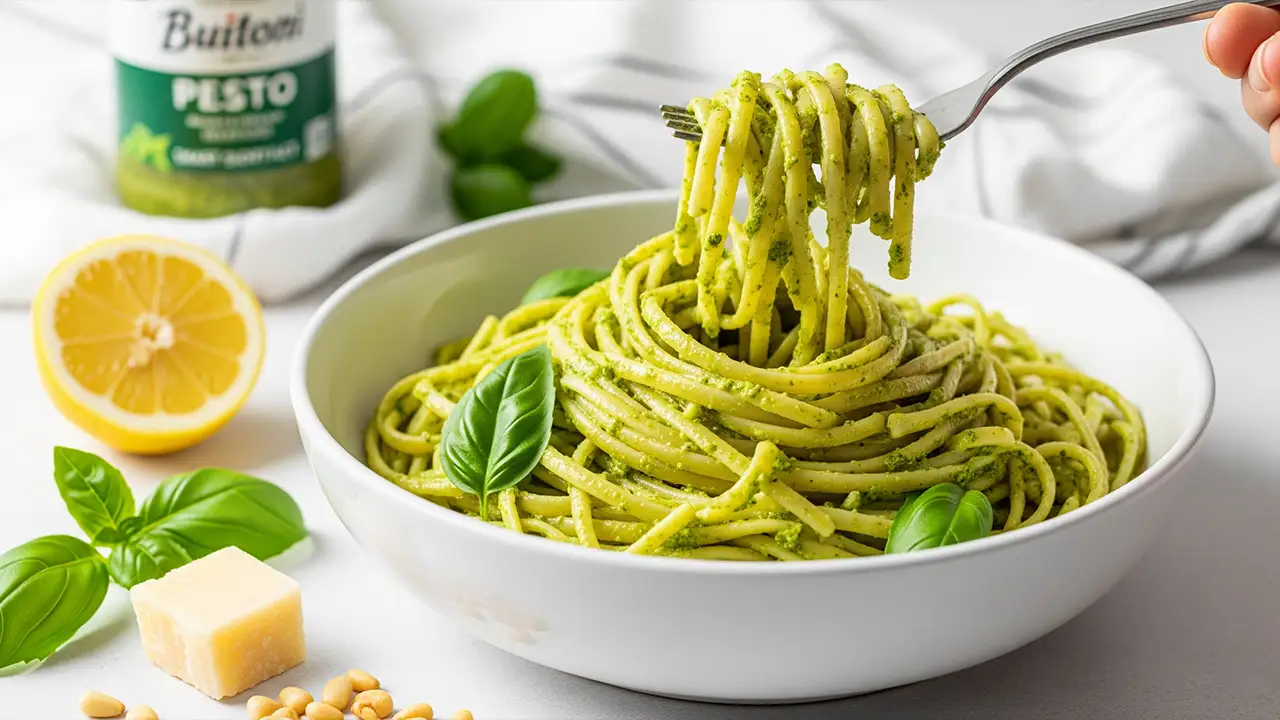
What if I told you that you’re only fifteen minutes away from a pasta dish that tastes like it came from a sunny Ligurian terrace, even on a busy Tuesday night? It sounds impossible. We’ve all been disappointed by store-bought pestos that taste flat, or homemade versions that turn brown and oily. We crave that vibrant, fresh pesto sauce but don’t always have the time. This guide unlocks that dilemma. This is The Ultimate Buitoni Pesto Recipe: Fresh Flavor, Fast.
This isn’t just about opening a container; it’s about a few simple store-bought pesto hacks that elevate a great product into something truly spectacular. This guide delivers homemade flavor with weeknight speed, one of my favorite pesto dinner ideas. This is the one.
So, grab a pot for pasta. Let’s make the quickest, most delicious pesto dish you’ve ever had.
My Quest for Perfection: A Pesto Revelation
I’ll be honest with you: for years, I was a pesto snob. I believed the only real pesto was the kind you painstakingly made yourself. My revelation came one evening when a friend, an incredible chef, challenged me to make a delicious dinner in under 20 minutes. Mortified, I saw the key ingredient on the counter: a container of Buitoni Pesto. I was skeptical, but I followed my friend’s lead.
That night, I didn’t just make a meal; I learned a lesson. By using the right technique, we created a dish that was breathtakingly fresh. This sent me on a new quest to master the art of the quick Italian meal.
I explored the history of pesto, from its origins in Genoa, Liguria, to the modern convenience that allows us to enjoy it year-round. My “aha!” moment was realizing that a high-quality refrigerated pesto like Buitoni isn’t a “cheat”—it’s a perfectly crafted, flavor-packed head start. My obsession became about finding the smartest ways to add back that “just-made” vibrancy, creating a buitoni pesto recipe that honors tradition without demanding hours. It’s one of my essential secrets for Quick Weeknight Italian Meals.
How Can I Make Buitoni Pesto Taste Homemade? The 7 Essential Elements
Achieving a spectacular pesto dish with Buitoni isn’t about luck; it’s about mastering seven key elements to elevate what’s already there. This is how you create the best jarred pesto experience (even though it comes from the fridge!).
Element 1: Why Starting with the Best Store-Bought Pesto is Key
Starting with a great product is essential. Buitoni pesto is refrigerated, not shelf-stable, which means it retains more of its fresh basil flavor and vibrant color. This gives us a high-quality foundation for our simple pesto recipe.
Element 2: Fresh Enhancements (Bringing it to Life)
This is how we add that “just-made” sparkle. A small handful of fresh basil, a squeeze of fresh lemon juice, or a finely grated garlic clove stirred in at the end will reawaken the pesto and make it taste like it was made from scratch.
Element 3: The Right Fat (Olive Oil Harmony)
Finishing your dish with a drizzle of high-quality, extra virgin olive oil adds a final, peppery note and a luxurious, silky texture to the sauce as it coats the pasta.
Element 4: Cheese & Nut Balance (Umami & Texture)
To boost the savory depth, stir in an extra handful of freshly grated Parmesan or Pecorino Romano cheese. For a wonderful texture, adding toasted pine nuts or even walnuts is a classic move for any buitoni pesto recipe.
Element 5: What is the Best Pasta for Pesto?
Pesto is a thick sauce that loves to cling. It demands pasta shapes with plenty of texture and surface area. Shapes with twists and curls (like fusilli, rotini, or casarecce) are ideal for grabbing every bit of that delicious sauce. Learn more in our complete guide on how to cook pasta perfectly.
Element 6: The No-Cook Rule for Fresh Pesto Flavor
This is the single most important technique. Never, ever heat pesto directly on the stove. High heat cooks the fresh basil, causing it to turn dark and bitter. The heat from the pasta and pasta water is all you need for a perfect fresh pesto sauce.
Element 7: Versatile Pesto Dinner Ideas
Mastering this enhanced pesto opens up a world of possibilities. Use it as a vibrant sandwich spread, a topping for simple grilled chicken, a dip for vegetables, or even in a pesto pasta salad.
How to Make Easy Pesto Pasta: The Step-by-Step Method
Now, let’s put all 7 elements into practice to create a simple, stunning pasta dish.
- Cook the Pasta: Bring a large pot of heavily salted water to a boil. Add your chosen pasta and cook until perfectly al dente.
- Reserve Pasta Water: Just before you drain the pasta, scoop out about a cup of the starchy, salty pasta water. This water is liquid gold; it’s the key to creating a creamy, emulsified sauce.
- Enhance the Pesto: While the pasta cooks, place your Buitoni pesto in a large serving bowl. Stir in your fresh enhancements—like extra basil, lemon juice, or garlic—and your extra cheese or nuts.
- Toss and Emulsify: Drain the hot pasta and immediately add it to the bowl with the enhanced pesto. Add a few tablespoons of the hot reserved pasta water and toss everything vigorously. The heat of the pasta warms the pesto, and the starchy water helps it transform into a creamy, luscious sauce that coats every piece. Add more pasta water until it reaches your desired consistency. Finish with a drizzle of good olive oil.
Your Buitoni Pesto Troubleshooting Guide
Even the quickest recipes can have hiccups. This guide helps you diagnose any issues with your buitoni pesto recipe.
| The Problem | The Likely Cause(s) (Element Failure) | The Foolproof Solution |
| My pesto tastes bland or flat. | Failure in Element 2. (No fresh enhancements were added). | Stir in a squeeze of fresh lemon juice, a little grated garlic, or some chopped fresh basil. A pinch of salt also helps to wake up the flavors. |
| My pesto is oily or separated. | Failure in Element 6. (The pesto was heated directly in a pan). | Always toss pesto with hot pasta off the heat. Vigorously whisk in a tablespoon of hot pasta water to help it emulsify again. |
| The pasta is dry; the sauce won’t cling. | Failure to use reserved pasta water. | Always reserve at least a cup of pasta water. It is the key ingredient for turning pesto into a creamy sauce that coats every noodle. |
| My pesto turned dark brown or black. | Failure in Element 6. (The fresh basil in the pesto was cooked over direct heat). | The “No-Cook Rule” is your best defense. Once basil is cooked, the vibrant green color is lost. For next time, use only the residual heat of the pasta. |
| The dish lacks freshness. | Failure in Element 2 or 7. (Lacked a final bright note). | A final squeeze of lemon juice or a shower of fresh basil just before serving is the best way to add a burst of freshness to your easy pesto pasta. |
Export to Sheets
Frequently Asked Questions (FAQ)
- How do I store opened Buitoni pesto? Pour a thin layer of olive oil over the surface of the leftover pesto in the container before sealing it. This prevents browning and it will last in the refrigerator for 5-7 days.
- Can I freeze Buitoni pesto? Yes, absolutely. Spoon it into an ice cube tray, freeze, and then transfer the pesto cubes to a freezer bag. This lets you use small portions as needed.
- What are the best types of pasta for pesto? Shapes with lots of nooks and crannies are best. Think fusilli, rotini, cavatappi, or even gnocchi. For long pasta, linguine or bucatini are excellent choices.
- Can I add meat to a pesto dish? Yes! Grilled chicken, shrimp, or even some crumbled Italian sausage are delicious additions. Cook the protein separately and toss it in with the pasta at the end.
- Is Buitoni pesto suitable for vegetarians? The classic Buitoni Basil Pesto is suitable for vegetarians. Always check the label for the specific variety you purchase.
The Ultimate Buitoni Pesto Recipe
- Prep time: 5 minutes
- Cook time: 10 minutes
- Yields: 4 servings
- Equipment: Large pot, large serving bowl
Ingredients
- 1 lb (450g) linguine, fusilli, or other desired pasta shape
- 1 (7 oz) container Buitoni Basil Pesto
- ½ cup freshly grated Parmesan cheese, plus more for serving
- 1 clove garlic, finely minced or grated (optional)
- 1 tablespoon fresh lemon juice
- ¼ cup toasted pine nuts (optional)
- High-quality extra virgin olive oil, for drizzling
- Salt and freshly ground black pepper, to taste
- A handful of fresh basil leaves, torn, for garnish
Instructions
- Boil Water & Cook Pasta: Bring a large pot of generously salted water to a rolling boil. Add your pasta and cook according to package directions until al dente.
- Reserve Pasta Water: Before draining, carefully scoop out and reserve about 1 ½ cups of the starchy pasta water.
- Prepare Pesto Base: While pasta cooks, add the Buitoni pesto, ½ cup of Parmesan, optional garlic, and lemon juice to a large serving bowl. Stir to combine.
- Drain & Combine: Drain the hot pasta and immediately add it to the serving bowl with the pesto mixture.
- Emulsify the Sauce: Add ½ cup of the hot reserved pasta water to the bowl. Using tongs, toss the pasta and pesto vigorously. The starchy water will combine with the pesto to create a creamy, emulsified sauce.
- Adjust Consistency: Continue to toss, adding more reserved pasta water a tablespoon at a time, until the sauce beautifully coats every noodle of your easy pesto pasta.
- Finish & Serve: Stir in the toasted pine nuts (if using). Taste and season with salt and pepper if needed. Serve immediately in warm bowls, garnished with fresh basil, more Parmesan, and a final drizzle of good olive oil.
Nutritional Profile (Approximate Values Per Serving, Pasta Included)
- Calories: 580 kcal
- Protein: 22g
- Fat: 25g
- Carbohydrates: 68g
- Fiber: 5g
- Sugar: 4g
